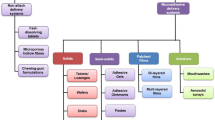Abstract
Purpose. To investigate the use of buccal bioadhesive device in targeting controlled drug delivery to the gastrointestinal tract.
Methods. A three-leg crossover study was designed to evaluate the application of buccal bioadhesive device for providing controlled drug delivery to the gastrointestinal tract of a model drug cyanocobalamin in four healthy adult male beagle dogs.
Results. In vitro dissolution studies using deionized water as the medium indicated that 100% of the drug was released within 15 min from a immediate release oral capsule formulation, whereas 90% of the drug was released within a period of 18 hrs from a buccal bioadhesive device formulation. Drug release from the buccal bioadhesive devices appeared to follow Higuchi's square root of time dependent model. The terminal half-life of the drug following I.V. administration in four dogs was found to be 16.4 ± 2.4 hrs. Following immediate release oral capsule administration of the drug Cmax, tmax and bioavailability were 2333 ± 1469 ng/L, 2.5± 1.0 hrs and 14.1 ± 7.9%, respectively. Following buccal bioadhesive device administration of the drug Cmax, tmax and bioavailability were 4154 ± 1096 ng/L, 11 ± 1.2 hrs and 35.8 ± 4.1%, respectively. Significantly higher bioavailability of the drug was observed with the buccal bioadhesive device administration when compared to the immediate release oral capsule.
Conclusions. The buccal bioadhesive device appears to improve the oral bioavailability of cyanocobalamin by providing controlled delivery of the drug to the gastrointestinal tract.
Similar content being viewed by others
REFERENCES
M. M. Veillard, M. A. Longer, T. W. Martens, and J. R. Robinson. Preliminary studies of oral mucosal delivery of peptide drugs. J. Contr. Rel. 6:123–131 (1987).
G. Ponchel. Formulation of oral mucosal drug delivery systems for the systemic delivery of bioactive materials. Adv. Drug Del. Rev. 13:75–87 (1994).
T. Nagai and Y. Machida. Buccal delivery systems using hydrogels. Adv. Drug Del. Rev. 11:179–191 (1993).
S. J. Pimlott and M. Addy. Evaluation of a method to study uptake of prednisolone sodium phosphate from different oral mucosal sites. Oral Surg. Oral Med. Oral Pathol. 60:35–37 (1985).
M. Ishida, N. Nambu, and T. Nagai. Mucosal dosage form of lidocaine for toothache using hydroxypropyl cellulose and carbopol. Chem. Pharm. Bull. 30:980–989 (1982).
T. Nagai and R. Konishi. Buccal/gingival drug delivery systems. J. Contr. Rel. 6:353–360 (1987).
T. Nagai, Y. Machida, and R. Konishi. Bioadhesive dosage forms for buccal/gingival administration. In V. Lenaerts and R. Gurny (eds.), Bioadhesive Drug Delivery Systems, CRC press, Florida, 1990, pp. 142.
Y. Nozaki, M. Kakumoto, M. Ohta, K. Yukimutsu, and Y. W. Chien. A new transmucosal therapeutic system. Drug Dev. Ind. Pharm. 19:221–275 (1993).
N. A. Peppas and J. R. Robinson. Bioadhesives for optimization of drug delivery. J. Drug Target. 3:183–184 (1995).
P. Bottenberg, R. Cleymae, C. Muynck, J. P. Remon, D. Coomans, Y. Michotte, and D. Slop. Development and testing of bioadhesive fluoride-containing slow-release tablets for oral use. J. Pharm. Pharmacol. 43:457–464 (1991).
P. Bottenberg, R. Cleymae, C. Muynck, J. P. Remon, D. Coomans, and D. Slop. Comparison of salivary fluoride concentrations after administration of a bioadhesive slow-release tablet and a conventional fluoride tablet. J. Pharm. Pharmacol. 44:684–686 (1992).
D. Tiwari, D. Goldman, R. Sause, and P. L. Madan. Evaluation of polyoxyethylene homopolymers for buccal bioadhesive drug delivery device formulations. Pharm. Res. 14:S–151 (1997)
L. B. Bailey. Vitamin chart no. 12. Nutr. Support Serv. 11:24 (1986).
K. Schumann, H. G. Classen, M. Hages, R. Prinz-Langenohl, K. Pietrzik, and H. K. Biesalski. Bioavailability of oral vitamins, minerals, and trace elements in perspective. Arzneim. Forsch. 47:369–380 (1997).
J. M. Scott. Bioavailability of vitamin B12. Eur. J. Clin. Nutr. 51:S49–S53 (1997).
A. Doscherholmen and P. S. Hagen. A dual mechanism of Vitamin B12 plasma absorption. J. Clin. Invest. 36:1551–1557 (1957).
E. L. Smith. Absorption, excretion, & distribution in the body. In R. Peter and F. G. Young (eds.), Methuen's Monographs on Biochemical Subjects, John Wiley & Sons, New York, 1965, pp. 132–133.
C. L. Cheng, S. H. Gehrke, and W. A. Ritschel. Development of an azopolymer based colonic release capsule for delivering proteins/macromolecules. Methods Find Exp. Clin. Pharmacol. 16:271–278 (1994).
G. Geisslinger, S. Menzel, O. Zoller, Zh. Cheng, and K. Brune. Absorption and distribution of ibuprofen and acetylsalicyic acid formulations. Drug Invest. 7:52–55 (1994).
M. Gibaldi and P. Perrier, Estimation of Areas—Appendix D. In J. Swarbick (ed.), Pharmacokinetics, Marcel Dekker, New York, 1982, pp. 445–449.
C. Li, P. P. Bhatt, and T. P. Johnston. Transmucosal delivery of oxytocin to rabbits using a mucoadhesive buccal patch. Pharm. Dev. Technol. 2:265–274 (1997).
K. C. Kwan, M. R. Dobrinska, J. D. Rogers, A. E. Till, and K. C. Yeh. Bioapharamceutics. In L. Lachman, H. A. Lieberman, and J. L. Kanig (eds.), The Theory and Practice of Industrial Pharmacy, Lea & Febiger, Pennsylvania, 1986, pp. 215–216.
M. Helliwell. The use of bioadhesives in targeted delivery within the gastrointestinal tract. Adv. Drug Del. Rev. 11:221–251 (1993).
A. Rubinstein and B. Tirosh. Mucus gel thickness and turnover in the gastrointestinal tract of the rat: response to cholinergic stimulus and implication for mucoadhesion. Pharm. Res. 11:794–799 (1994)
Author information
Authors and Affiliations
Rights and permissions
About this article
Cite this article
Tiwari, D., Goldman, D., Town, C. et al. In Vitro-In Vivo Evaluation of a Controlled Release Buccal Bioadhesive Device for Oral Drug Delivery. Pharm Res 16, 1775–1780 (1999). https://doi.org/10.1023/A:1018922503145
Issue Date:
DOI: https://doi.org/10.1023/A:1018922503145




